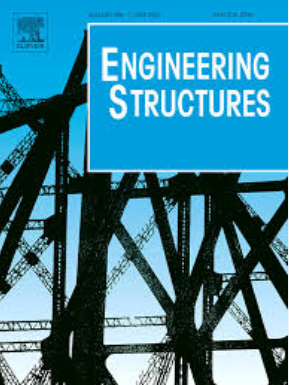带ECC护套的FRP螺旋条形约束混凝土圆柱:耐火性能和火后压缩性能
IF 5.6
1区 工程技术
Q1 ENGINEERING, CIVIL
引用次数: 0
摘要
树脂基体的高温脆弱性阻碍了外键合(EB)纤维增强聚合物(FRP)增强体系的广泛应用。为了应对这一挑战,工程胶凝复合材料(ECC)因其良好的防火性能而有望成为frp增强结构的一种有前途的耐火材料。在此背景下,本研究引入了一种创新的方法,将ECC设计为EB FRP系统的外层。考虑多个试验变量,对带和不带ECC护套的FRP螺旋条形混凝土(FSSCC)圆形柱在火灾后的传热进行了详细的分析和实验程序。试验结果表明,添加ECC护套使试件的FRP温度远低于树脂基体的分解极限,显著提高了试件的耐火性能,并改善了试件的结构性能,包括承载能力和延性。此外,在火灾暴露后,ecc夹套的FSSCC试件在抗压强度和应力-应变行为方面存在不可忽略的尺寸效应。这些研究结果表明,在高温条件下,带ECC护套的FSSCC柱是有效的,为进一步发展耐火高性能结构加固体系提供了坚实的实验基础。本文章由计算机程序翻译,如有差异,请以英文原文为准。
FRP spiral strip-confined concrete circular columns with ECC jackets: Fire resistance and post-fire compressive behavior
The vulnerability of resin matrix to high temperatures has hindered the wider application of externally bonded (EB) fiber-reinforced polymer (FRP) strengthening systems. In response to this challenge, engineered cementitious composite (ECC) is expected to be a promising fire-resistive material for FRP-strengthened structures due to its good fire performance. Against this background, this study introduces an innovative approach by designing ECC as an external layer for EB FRP systems. A detailed heat transfer analysis and experimental program was conducted on FRP spiral strip-confined concrete (FSSCC) circular columns with and without ECC jackets after fire exposure, with the consideration of several test variables. The test results showed that the supplemental ECC jackets significantly enhanced the fire resistance of test specimens by maintaining the FRP temperatures far below the decomposition limit of resin matrix, and also improved their structural performance, including load-carrying capacity and ductility. Besides, a non-negligible size effect in terms of compressive strength and stress-strain behavior was noticed in the ECC-jacketed FSSCC specimens after fire exposure. These findings show the effectiveness of FSSCC columns with ECC jackets at elevated temperatures, providing a solid experimental foundation for advancing the fire-resistant, high-performance structural strengthening system.
求助全文
通过发布文献求助,成功后即可免费获取论文全文。
去求助
来源期刊

Engineering Structures
工程技术-工程:土木
CiteScore
10.20
自引率
14.50%
发文量
1385
审稿时长
67 days
期刊介绍:
Engineering Structures provides a forum for a broad blend of scientific and technical papers to reflect the evolving needs of the structural engineering and structural mechanics communities. Particularly welcome are contributions dealing with applications of structural engineering and mechanics principles in all areas of technology. The journal aspires to a broad and integrated coverage of the effects of dynamic loadings and of the modelling techniques whereby the structural response to these loadings may be computed.
The scope of Engineering Structures encompasses, but is not restricted to, the following areas: infrastructure engineering; earthquake engineering; structure-fluid-soil interaction; wind engineering; fire engineering; blast engineering; structural reliability/stability; life assessment/integrity; structural health monitoring; multi-hazard engineering; structural dynamics; optimization; expert systems; experimental modelling; performance-based design; multiscale analysis; value engineering.
Topics of interest include: tall buildings; innovative structures; environmentally responsive structures; bridges; stadiums; commercial and public buildings; transmission towers; television and telecommunication masts; foldable structures; cooling towers; plates and shells; suspension structures; protective structures; smart structures; nuclear reactors; dams; pressure vessels; pipelines; tunnels.
Engineering Structures also publishes review articles, short communications and discussions, book reviews, and a diary on international events related to any aspect of structural engineering.
 求助内容:
求助内容: 应助结果提醒方式:
应助结果提醒方式:


